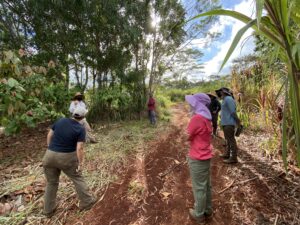Final report for OW17-037
Project Information
Cacao (Theobroma cacao) is a tropical perennial crop that produces the seeds used to manufacture chocolate, cocoa butter and related products. Cacao has economic potential in Hawaii due to the value-added production of chocolate and Hawaii’s established brand value for specialty foods, but was not an established commercial crop prior to the 21st century. Cacao acreage planted in Hawaii has increased more than five-fold since 2010, from just over 20 acres to more than 100 in 2016, with an additional 363 acre equivalents of new plantings planned by 2021. Cacao orchards reach full production five years or more after planting; therefore, improving orchard establishment is a high priority.
There is a lack of published information on orchard management guidelines for cacao adapted to Hawaii's local soil and environmental variables. This knowledge gap is often overcome through trial and error, delaying success and reducing overall production. Project staff, partners and collaborating producers documented best practices and evaluated nutrient management practices used during cacao orchard establishment. Results were shared with Hawaii's growing number cacao operations. Locally-adapted nutrient management guidelines when combined with other best practices hold the potential to increase the success rate of cacao establishment by improving seedling growth, nutrition and precocity. Successful establishment allows the best opportunity for Hawaii’s cacao industry to grow quickly and achieve adequate quality and quantity of harvest to capture economies of scale.
1. Evaluate economic costs and seedling growth benefits of site-specific nutrient management and best practices during cacao orchard establishment.
- The financial costs of cacao nutrient management and best practices for establishment were gathered from participating producer farms.
- An on-farm trial was established with five participating producer farms in diverse geographic zones of cacao production on the islands of Oahu and Hawaii (aka Big Island). The trial planting was established on five farms in the last quarter of 2018 and growth data was collected over a 24 month period.
- The seedling growth benefits of nutrient management was assessed over a 24 month period under three treatments: (f) farm practice, (b) best practices informed by soil analysis and agronomist recommendations (m) same as treatment two plus a mycorrhizal soil amendment.
- Anecdotal feedback, observations and lessons learned were gathered from farmers at each of the host sites.
2. Share results with producers and other agricultural professionals.
- An online survey gauged cacao farmer familiarity and usage of soil testing, leaf tissue analysis and site-specific nutrient management guidelines for cacao. Only 36% of respondent farmers indicated conducting soil testing or receiving recommendations from an agronomist or extension agent. Less than 10% used tissue analysis to determine nutrition needs.
- Three field days were held to demonstrate effects of soil management and best practices on cacao establishment. Field days included presentations from the host farmer, as well as agricultural professionals and a tour or hands-on activity.
- Two tutorial videos on cacao establishment were produced and published online, as well as a webinar featuring a panel discussion with experienced growers.
- Resources were disseminated via social media networks and producer-to-producer networks, such as the 2019 Hawaii Chocolate and Cacao Conference, which is attended by 100 or more cacao and chocolate industry professionals.
Cooperators
- (Educator)
- (Researcher)
- (Researcher)
- (Researcher)
- (Researcher)
- (Researcher)
- (Educator and Researcher)
- (Educator and Researcher)
- (Researcher)
Research
Objective 1 : Evaluate economic costs and seedling growth benefits of site-specific nutrient management best practices during cacao orchard establishment.
Three hundred cacao seedlings (half sibling progeny of Hawaii State Cacao Trial clone #4) received three nutrient management treatments to assess the effects of the biological soil amendment on cacao growth during the establishment phase. Five farm sites with experience growing cacao participated in the trial as farmer researchers and planted sixty seedlings each, twenty per treatment. Planting density followed the standard grid at each site, all using 8-10 ft. spacing in row and 10 ft. between rows. For the best practices and mycorrhizal treatments, site-specific soil amendments were applied with a cubic foot of backfilled soil at the time of planting, based on soil analysis results and the recommendations of an experienced agronomist. The objective of the pre-plant soil amendments was to balance pH, calcium and magnesium and provide phosphorus; amendments used were dolomite, calcium carbonate, gypsum, monoammonium phosphate and compost. For the mycorrhizal treatment (m), a commercially available biological amendment containing multiple species of endo and ectomycorrhizae, as well as trichoderma was applied with backfilled soil at the time of planting at a rate of 0.3 ounce (2 teaspoons) per cubic foot.
For the best practices and mycorrhizal treatments, all sites topdressed 12 ounces of fertilizer (10-20-20 plus minor nutrients) on a quarterly basis (0.3 lb. of nitrogen per tree per year) , supplemented with foliar application of liquid fertilizer at a rate of 1 ounce per gallon every 2-4 weeks to provide micronutrients, magnesium and sulfur. The farm practice treatment was determined by the farmer researcher from each site based on their existing practice: site a fertigated 15-5-15 plus Cal-Mag on a weekly basis with monthly application of potassium, site b topdressed fertilizer (10-20-20 plus micronutrients) starting at 2 ounces per tree every quarter and augmenting to 6 ounces per tree by year two, site c topdressed 2 ounces per tree of fertilizer (16-16-16) every 6 weeks for year one, augmenting to 5 ounces in year two, site d topdressed 4 ounces of tankage per tree every quarter, and site e topdressed 4 ounces of tankage per tree every quarter with compost.
The basal diameter of each seedling was measured 15-43 days after transplant and again 24 months after the initial measurement to assess the effects of each nutrient management treatment on seedling growth. A digital caliper with sub-millimeter accuracy was used for basal diameter measurements. Height, jorquette height and canopy dimensions were measured at 24 months and farmer researchers completed an online questionnaire to document their observations on each treatment, limiting factors for cacao growth at their site, input costs and other lessons learned.
A two-way ANOVA was conducted to test the effects of nutrient management treatment and farm site on seedling growth. We found no statistically-significant difference in average seedling diameter by nutrient management treatment (f(1)=0.636, p= 0.53) in contrast with a statistically-significant difference in average seedling diameter by farm site (f(2)=27.670, p<2e-16). Consequently, we assessed the effects of nutrient management treatment on average seedling diameter for each farm site individually and found statistically-significant differences in average seedling diameter by nutrient management treatment at site b (f=10.68, p=0.000217, see Figure 2) and site d (f=19.32, p=4.41e-07, see Figure 3); no statistically significant differences were found at sites a (f=1.175, p=0.316, see Figure 3), c (f=1.285, p=0.286, see Figure 4), or e (f=1.407, p=0.254, see Figure 5).
For site b , a Tukey post-hoc test indicated that existing farm practices treatment resulted in a larger basal diameter on average (52.3 mm) than the best practices treatment (33.7 mm) and a larger basal diameter on average than the mycorrhizal treatment (31.7 mm). For site d, a Tukey post-hoc test indicated that the mycorrhizal treatment demonstrated a larger basal diameter on average (58.5 mm) than the best practices treatment (43.9 mm) and a larger basal diameter on average than the existing farm practices treatment (35.7 mm). Due to unforeseen within field variability, which is further discussed below, and the absence of significant differenced between treatments at other sites in the trial, these results are not conclusive.
Twenty-four months after planting, farmer researchers completed an online questionnaire to document their observations on each treatment and limiting factors for cacao growth at their site (see table 1). These observations identified within field variation due to wind exposure (sites b, d and e), leaks and other irrigation failures (sites c, d and e), and visual signs of plant stress due to excess or insufficient nitrogen (sites b, c, d and e). All sites reported significant pest damage due to leaf predation from Chinese rose beetle (Adoretus sinicus), and trees at two sites suffered from ungulate damage (asinine and feral swine). Limiting factors resulted in significant mortality rates of up to 15% and 33% (site c and b, respectively).
Table 1. Limiting Factors by Site
| a | b | c | d | e | Total | |
| wind | + | + | + | 3 | ||
| Chinese rose beetle | + | + | + | + | + | 5 |
| insufficient / irregular water | + | + | + | 3 | ||
| excess / insufficient nitrogen | + | + | + | + | 4 | |
| ungulate | + | + | 2 | |||
| herbicide drift | + | 1 | ||||
| Inadequate shade | + | 1 | ||||
| weeds (nutrient competition) | + | 1 | ||||
| mortality | 0% | 33% | 15% | 3% | 10% | 12% |
An estimate of input costs for the establishment phase was collected with input from the trial's farmer researchers. Though actual pricing varies in time and based on volume, the components of input costs provide insight into the relative value to the farmer of any additional dollar spent on inputs. The tankage used as the primary fertilizer with positive results in the farm treatment at site e has an annual cost during establishment of $0.96/tree in comparison to $6.06 per year for the conventional 10-20-20 fertilizer.
Table 2. Establishment Input Costs*
| $ / tree | % of per tree cost | |
| seedling | $4.50 | 17% |
| irrigation and emitters | $0.43 | 2% |
| weed barrier (& staples) | $4.39 | 17% |
| tree cage (& stake) | $8.50 | 32% |
| soil amendments (pre-plant) | $0.19 | 1% |
| fertilizer, annual | $6.06 | 23% |
| mycorrhizal amendment | $2.31 | 9% |
| $26.37 | 100% | |
|
*all costs are approximate and vary based on volume of purchase
|
||
In 2019, a cacao nursery trial was conducted to screen and identify a promising commercially available mycorrhizal soil amendment to use in the on-farm component of the trial. Growth rate (basal diameter, height, leaf count) was recorded for seven treatments: control (no fertilizer), control plus 75% commercial practice fertilizer, control plus 100% commercial practice fertilizer, amendment 1 + 75% fertilizer , amendment 2 + 75% fertilizer, amendment 3 plus 75% fertilizer, amendment mix (1-3) plus 75% fertilizer. Root samples were collected to be analyzed for colonization by the biological amendments in an ongoing research collaboration. Preliminary results indicate small but statistically significant increase in growth for two of the amendments over the control treatment, one of which was selected for use in the on-farm component of the trial.
Research Outcomes
Education and Outreach
A half-day workshop led by Dr. Nhu Nguyen for LCC student researchers to learn lab procedures for obtaining root samples from cacao seedlings and preparing the the samples to assess the colonization by myccorhizal soil amendments.
Participation Summary:
Objective 2 (outreach): share results with producers and other agricultural professionals.
- An online survey gauged cacao farmer familiarity and usage of soil testing, leaf tissue analysis and site-specific nutrient management guidelines for cacao. Only 36% of respondent farmers indicated conducting soil testing or receiving recommendations from an agronomist or extension agent. Less than 10% used tissue analysis to determine nutrition needs.
- Three field days were held to demonstrate effects of soil management and best practices on cacao establishment. Field days included presentations from the host farmer, as well as agricultural professionals and a tour or hands-on activity.
- Findings were shared at the 2019 Hawaii Chocolate and Cacao Conference, which is attended by 100 or more cacao and chocolate industry professionals.
- Publish a fact sheet and informational video.
- Disseminate resources, results and related information via social media networks and producer-to-producer networks.
2020
A webpage (https://oahurcd.org/portfolio/cacao/) was published with the following educational tools:
- A video tutorial titled "How to Establish a Cacao Orchard",
- A video tutorial titled "How to Grow Cacao from Seed",
- A webinar recording of a panel discussion with experienced growers from different islands titled "Getting Started with Cacao", and
- A resource guide for new growers, compiling the best resources for cacao production in Hawaii, contact info for relevant service providers such as extension agents, researchers, nurseries, agronomists, and cacao buyers, ann annotated bibliography of extension publications, videos and websites, and a list of cacao grower organizations, educational providers and opportunities, such as chocolate festivals with educational components.
These tools were also promoted via Oahu RC&D's email newsletter (circulation 3,500+) and social media accounts (2,000+ followers).
A half-day workshop was organized on Oahu in July, 2020, following COVID social distancing protocols and attended by 11 people, including 8 self-identifying farmers (other participants were prospective farmers). Social distancing measures were observed by all participants. Three experienced farmers and cacao experts gave presentations, which were coupled with a hands-on pruning training in orchard plots of different ages. The positive results of best practices for seedling survival and growth were also viewed in blocks of recently planted cacao.
Cacao pruning demonstration with COVID precautions (July, 2020)
Project staff worked with UH CTAHR extension agents for a half-day on cacao formation pruning and establishment practices to support the uptake of cacao information and resources by the extension service and advance a demo planting at the Waimanalo Research Station.
2019
A presentation was provided to beginning cacao farmers and existing farmers interested in cropping cacao on Maui in November, 2019, highlighting key orchard establishment issues to address at the site selection and planning stage, such as windbreak design and scale. Additional information was shared on business planning, with an emphasis on the importance of value-added production and ag-tourism to achieve viability on small cacao farms in Hawaii (e.g. less than 10 acres).
A presentation was given at the 2019 Hawaii Chocolate and Cacao Association on the results of the annual Hawaii Cacao Survey, including information on priority issues identified by cacao growers, assessing the relative importance of orchard establishment and management training alongside other needs such as business and ag-tourism development.
2018
The project coordinator gave a presentation at the Hawaii Chocolate and Cacao Association's 2018 annual meeting and conference to share information about the trial and outreach events with estimated seventy farmers and industry professionals (approximately 30 cacao farmers). A short video synopsis of the event was published by the HCCA https://youtu.be/ou_A8qs252s?t=256.
A full-day workshop was organized on Hawaii Island in July, 2018, and attended by 43 people, including 19 self-identifying farmers (other participants were service providers, prospective farmers, chocolate makers and agri-tourism operators). Eight experienced farmers and cacao experts gave presentations, which were coupled with a hands-on formation pruning training in an established orchard, a hands-on cacao planting and tree cage installation session (best practices) in an established orchard, and three tours of working cacao farms. Information was also provided on Hawaii's cacao industry and its unique niche within the global chocolate market, including talks from local cacao buyers on their quality standards, and the group participated in a quality assessment (and tasting!) to learn to distinguish between off-grade and world-class, fine cacao.
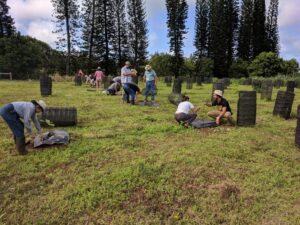
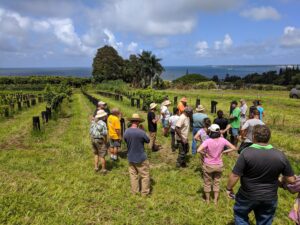
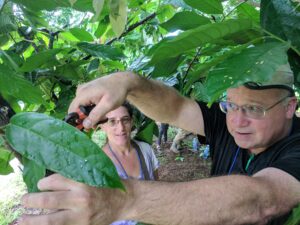

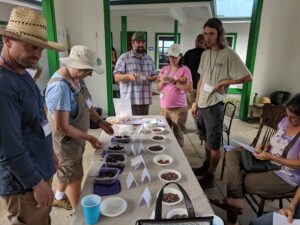
The trial was installed at five host farms from September through December, 2018. At each site, the project coordinator facilitated the documentation of best practices for successful cacao establishment with input from soil agronomist Pete Bunn of Crop Nutrient Solutions, Inc., Dan O'Doherty of Cacao Services, Inc. and the host farm.
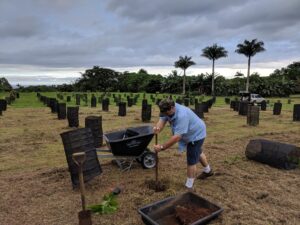
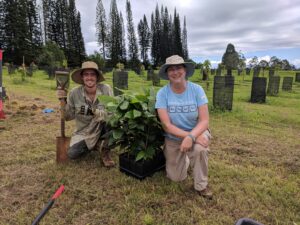
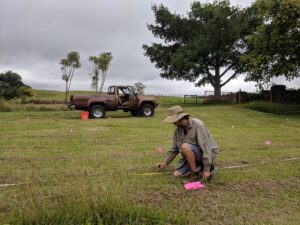
A second full-day workshop-style event was organized on Oahu in December, 2018, and attended by 27 people, including 10 farmers (other participants were service providers, prospective farmers, chocolate makers and backyard growers). Six experienced farmers and cacao experts gave presentations, which were coupled with a hands-on formation pruning training session in an established orchard and a hands-on cacao planting and tree cage session (best practices) in an established orchard. Information was also provided on Hawaii's cacao industry and its unique niche within the global chocolate market, including talks from local cacao buyers on their quality standards, and the group participated in a quality assessment (and tasting!) to learn to distinguish between off-grade and world-class, fine cacao.
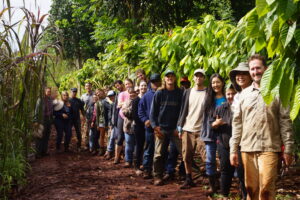
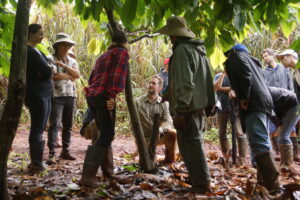
Project staff worked with UH CTAHR extension agents for a half-day on cacao grafting and establishment practices to support the uptake of cacao information and resources by the extension service, advance a demo planting at the Waimanalo Research Station and enable future collaboration on outreach events.
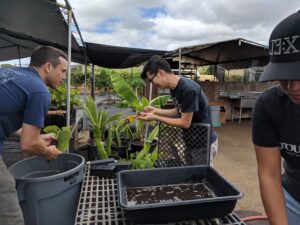
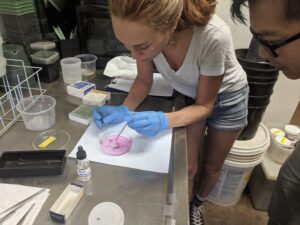
Education and Outreach Outcomes
The project's on-farm, hands-on training events, which combined presentations by ag professionals with testimonials from experienced farmers and hands-on tutorials, were extremely well received by participants. Though this type of outreach is more time and resource intensive to organize than a traditional field day, it paid off in the form of positive outcomes for farmers (and the project).
Due to the trial's reliance on host farms with limited time, randomized complete block design (RCBD) was not used. RCBD would have required inordinate amounts of labor and attention by host farmers to varying fertilizer applications for the dispersed trees in each treatment. For future efforts, I recommend securing additional funds (or for Western SARE to increase project funding cap) to allow for paid staff to conduct all fertilizer applications and data collection in a RCBD, which entails higher costs in perennial cropping systems and due to Hawaii's geography and inter-island air travel.
The total of 33 participants who self-identified as farmers at the project's two workshop-style events rated the likelihood of implementing the information presented at the event on their property as a 9 on a 10-point scale, based on the results of the anonymous, written event evaluation. The events' content focused on best practices for successful cacao establishment, as well as orchard design and business planning for cacao farming in Hawaii (a more detailed description is provided in the activities section of this report).
